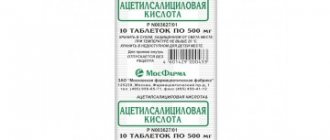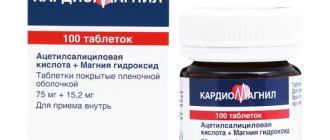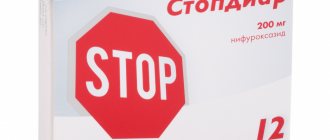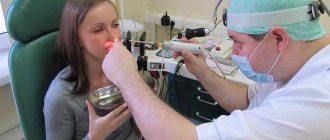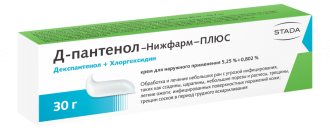How to drink acetylsalicylic acid correctly
An adult patient with active rheumatism is prescribed to take about 6-7 g of ASA per day. Frequency of administration – up to 5 times a day. The duration of the treatment course is 1.5 months. Throughout the course, the dose remains unchanged.
Discontinuation of the drug in adults and children should occur gradually, over 8-12 days.
If a person suffers from headaches or has an increased body temperature, then the medicine is taken in smaller quantities. For fever and pain of various origins, it will be enough to take up to 1 g at a time. Up to 5 doses are allowed per day.
It is worth noting that aspirin will help cope with headaches if they were caused by increased intracranial pressure.
The treatment course should not last more than 14 days.
In order to prevent thrombosis, you need to drink the medicine up to 3 times a day, 0.5 g.
Buy Acetylsalicylic acid FST tablets 500 mg No. 10 in pharmacies
Trade name:
Acetylsalicylic acid
International nonproprietary or generic name:
Acetylsalicylic acid
Dosage form:
Compound
Active ingredient: acetylsalicylic acid - 500.0 mg.
Excipients: potato starch - 72.1 mg, citric acid - 0.2 mg, stearic acid - 6.0 mg, talc - 12.7 mg, colloidal silicon dioxide (Aerosil) 3.0 mg, sodium carboxymethyl starch (sodium starch glycolate) - 6.0 mg.
Description:
round flat-cylindrical tablets of white or almost white color, slightly marbled.
Pharmacotherapeutic group:
non-steroidal anti-inflammatory drug
Pharmacological properties
Pharmacodynamics
The drug has analgesic, antipyretic and anti-inflammatory effects. The mechanism of action of acetylsalicylic acid is based on inhibition of the activity of the cyclooxygenase enzymes COX-1 and COX-2, which are involved in the synthesis of prostaglandins, prostacyclins and thromboxane. As a result, the synthesis of prostaglandins, which ensures the formation of edema and hyperalgesia, is disrupted. A decrease in the content of prostaglandins (mainly E 1) in the thermoregulation center leads to a decrease in body temperature due to dilation of skin vessels and increased sweating processes. The analgesic effect is due to both central (influence on the centers of pain sensitivity) and peripheral (decreasing the algogenic activity of bradykinin) action. The anti-inflammatory effect of the drug is due to a decrease in the synthesis of prostaglandins, a decrease in capillary permeability, a decrease in hyaluronidase activity, and a limitation of the energy supply to the inflammatory process by inhibiting the formation of adenosine triphosphoric acid.
Reduces platelet aggregation and adhesion and inhibits thrombus formation by suppressing the synthesis of thromboxane A2 in platelets.
Blockade of COX-1 in the gastric mucosa leads to inhibition of the synthesis of gastroprotective prostaglandins, which can contribute to ulceration of the gastric mucosa and subsequent bleeding.
Pharmacokinetics
When taken orally, absorption is complete. During absorption, it undergoes systemic elimination in the intestinal wall and in the liver (deacetylated). The resorbed part is quickly hydrolyzed by special esterases, so the half-life of the drug is no more than 15-20 minutes.
It circulates in the body (75-90% due to albumin) and is distributed in tissues in the form of salicylic acid anion.
The time to reach maximum plasma concentration is 2 hours. Serum levels of salicylates are highly variable. Salicylates easily penetrate many tissues and body fluids, incl. into the cerebrospinal, peritoneal and synovial fluids. Penetration into the joint cavity accelerates in the presence of hyperemia and edema and slows down in the proliferative phase of inflammation. Salicylates are found in small quantities in brain tissue, traces in bile, sweat, and feces. When acidosis occurs, most of the salicylic acid is converted into non-ionized acid, which penetrates well into tissues, incl. into the brain. It quickly passes through the placenta and is excreted in small quantities in breast milk.
Metabolized primarily in the liver to form 4 metabolites found in many tissues and urine.
It is excreted primarily through the active section in the renal tubules unchanged (60%) and in the form of metabolites.
The excretion of unchanged salicylate depends on the pH of the urine (with alkalinization of the urine, the ionization of salicylates increases, their reabsorption worsens and excretion increases significantly). The rate of elimination depends on the dose: when taking small doses, the half-life of the drug is 2-3 hours, with increasing doses it can increase to 15-30 hours.
In newborns, salicylates can displace bilirubin from its binding to albumin and contribute to the development of bilirubin encephalopathy. Elimination of salicylates in newborns is much slower than in adults.
Indications for use
Symptomatic treatment of pain, headache (including withdrawal symptoms), toothache, sore throat, migraine pain, back and muscle pain, joint pain, menstrual pain.
Increased body temperature during colds and other infectious and inflammatory diseases (in adults and children over 15 years of age).
Contraindications
- Hypersensitivity to acetylsalicylic acid and other non-steroidal anti-inflammatory drugs or other components of the drug; - erosive and ulcerative lesions of the gastrointestinal tract (in the acute phase), gastrointestinal bleeding; - bronchial asthma induced by taking salicylates and non-steroidal anti-inflammatory drugs; - hemorrhagic diathesis; - combined use of methotrexate at a dose of 15 mg per week or more; - pregnancy, breastfeeding period; - a combination of bronchial asthma, recurrent polyposis of the nose and paranasal sinuses and intolerance to acetylsalicylic acid; - children under 12 years of age (for this dosage form)
The drug is not prescribed to children under 15 years of age with acute respiratory diseases caused by viral infections due to the risk of developing Reye's syndrome (encephalopathy and acute fatty liver degeneration with acute development of liver failure).
Carefully
With concomitant therapy with anticoagulants, gout, gastric ulcer and/or duodenal ulcer (history), including chronic or recurrent peptic ulcer, or episodes of gastrointestinal bleeding; renal and/or liver failure, glucose-6-phosphate dehydrogenase deficiency; hyperuricemia, bronchial asthma, chronic obstructive pulmonary disease, hay fever, nasal polyposis, drug allergies, concomitant use of methotrexate at a dose of less than 15 mg/week, pregnancy.
Use during pregnancy and breastfeeding
The use of acetylsalicylic acid is contraindicated in the first and third trimesters of pregnancy. The use of acetylsalicylic acid in the first trimester of pregnancy, due to its teratogenic effect, leads to an increase in the incidence of fetal developmental defects (cleft palate, cardiovascular anomalies), in the third trimester it causes inhibition of labor, premature closure of the ductus arteriosus in the fetus, increased bleeding in mother and fetus. Administration immediately before birth may cause intracranial hemorrhage, especially in premature infants.
The use of the drug in the second trimester of pregnancy is contraindicated due to the impossibility of implementing its dosage regimen in this dosage form.
Breastfeeding period
Salicylates and their metabolites pass into breast milk. During treatment with the drug, breastfeeding should be stopped.
Directions for use and doses
Orally, adults and children over 12 years of age: single dose is 0.5 g, maximum single dose is 1.0 g (2 tablets of 0.5 g), maximum daily dose is 3.0 g (6 tablets of 0.5 g .
Directions for use: the drug should be taken after meals with water, milk or alkaline mineral water.
Frequency and time of administration: a single dose, if necessary, can be taken 3-4 times a day with an interval of at least 4 hours. Regular adherence to the drug regimen allows you to avoid a sharp increase in temperature and reduce the intensity of pain.
The duration of treatment (without consulting a doctor) should not exceed 5 days when prescribed as an analgesic and more than 3 days when prescribed as an antipyretic.
Side effect
From the gastrointestinal tract: loss of appetite, diarrhea; abdominal pain, heartburn, nausea, vomiting, obvious (vomiting with blood, tarry stools) or hidden signs of gastrointestinal bleeding, which can lead to iron deficiency anemia, erosive and ulcerative lesions (including perforation) of the gastrointestinal tract, isolated cases of liver dysfunction (increased liver transaminases).
From the central nervous system: dizziness, tinnitus (usually signs of overdose).
From the hematopoietic system: increased risk of bleeding, which is a consequence of the effect of acetylsalicylic acid on platelet aggregation, thrombocytopenia, anemia, leukopenia.
Allergic reactions: skin rash, anaphylactic reactions, bronchospasm, Quincke's edema.
From the genitourinary system: impaired renal function.
Others: when taken as an antipyretic drug, Reye's syndrome (encephalopathy and acute fatty liver with rapid development of liver failure).
Overdose
Symptoms
Moderate overdose: nausea, vomiting, tinnitus, hearing loss, headache, dizziness and confusion.
Severe overdose: fever, hyperventilation, ketoacidosis, respiratory alkalosis, metabolic acidosis, coma, cardiogenic shock, respiratory failure, severe hypoglycemia.
Treatment: hospitalization, gastric lavage, activated charcoal, monitoring of acid-base balance, alkaline diuresis in order to obtain a urine pH between 7.5-8 (forced alkalinization of urine is considered achieved if the concentration of salicylate in the blood plasma is more than 500 mg/ l (3.6 mmol/l) in adults or 300 mg/l (2.2 mmol/l) in children), hemodialysis, replacement of fluid loss, symptomatic therapy.
Interaction with other drugs
Combined use:
- with methotrexate at a dose of 15 mg per week or more: the hemolytic cytotoxicity of methotrexate increases (renal clearance of methotrexate decreases and methotrexate is replaced by salicylates in connection with blood plasma proteins); - with indirect anticoagulants and heparin: the risk of bleeding increases due to inhibition of platelet function, damage to the mucous membrane of the gastrointestinal tract, displacement of anticoagulants (oral) from connection with blood plasma proteins; - with other non-steroidal anti-inflammatory drugs: as a result of synergistic interaction, the risk of ulcers and gastric bleeding increases; - with uricosuric drugs. for example benzbromarone: reduces the uricosuric effect; - with digoxin: digoxin concentration increases due to decreased renal excretion; - enhances the effects of oral hypoglycemic drugs; - with thrombolytic drugs: the risk of bleeding increases; - with systemic glucocorticosteroids. excluding hydrocortisone, used as replacement therapy for Addison's disease: when using glucocorticosteroids, the level of salicylates in the blood decreases due to increased excretion of the latter; - with angnotensin-converting enzyme inhibitors: glomerular filtration is reduced due to inhibition of prostaglandins and, as a result, the antihypertensive effect is reduced; - with valproic acid: the toxicity of valproic acid increases; - with ethanol (alcoholic drinks): the risk of damaging the gastrointestinal mucosa increases and the risk of bleeding in the gastrointestinal tract increases; - enhances the effects of narcotic analgesics, thrombolytics and platelet aggregation inhibitors, sulfonamides (including co-trimoxazole); - increases the concentration of barbiturates and lithium salts in plasma; - antacids containing magnesium and/or aluminum slow down and impair the absorption of acetylsalicylic acid; - myelotoxic drugs increase the manifestations of hematotoxicity of the drug; - enhances the effects of triiodothyronine; - reduces the effect of antihypertensive drugs, diuretics (spironolactone, furosemide).
Glucocorticoids, ethanol and ethanol-containing drugs increase the damaging effect of acetylsalicylic acid on the mucous membrane of the gastrointestinal tract and increase the risk of gastrointestinal bleeding.
special instructions
Acetylsalicylic acid may cause bronchospasm, an attack of bronchial asthma or other hypersensitivity reactions. Risk factors are the presence of bronchial asthma, nasal polyps, fever, chronic bronchopulmonary diseases, a history of allergies (allergic rhinitis, skin rashes). Acetylsalicylic acid may increase the tendency to bleeding, which is associated with its inhibitory effect on platelet aggregation. This should be taken into account when surgical interventions are necessary, including minor interventions such as tooth extraction. Before surgery, to reduce bleeding during surgery and in the postoperative period, you should stop taking the drug 5-7 days in advance and notify the doctor.
Children with acute viral infections should not be prescribed medications containing acetylsalicylic acid, since in the case of a viral infection the risk of Reye's syndrome increases. Symptoms of Reye's syndrome are prolonged vomiting, acute encephalopathy, and liver enlargement.
If it is necessary to use the drug during lactation, breastfeeding should be discontinued.
Acetylsalicylic acid reduces the excretion of uric acid from the body, which can cause an acute attack of gout in predisposed patients.
Impact on the ability to drive vehicles and machinery
During the treatment period, care must be taken when driving vehicles and engaging in potentially hazardous activities that require increased concentration and speed of psychomotor reactions, since the use of the drug can in rare cases cause dizziness.
Release form
Tablets 500 mg.
10 tablets in blister-free or blister packs;
1, 2, 3, 4 or 5 blister packs with instructions for use in a cardboard pack. It is allowed to place contour cell and cell-free packages in group packaging with an equal number of instructions.
Storage conditions
Store at a temperature not exceeding 25C. Keep out of the reach of children.
Best before date
4 years. After the expiration date, do not use the drug.
Vacation conditions
Over the counter.
How to take acetylsalicylic acid for children
The optimal dose for children is determined taking into account weight (approximately 100-120 mg per 1 kg per day). For active rheumatism, it should be taken up to 5 times a day. After 10-15 days from the start of the therapeutic course, the dosage can be reduced by 1.5 times. Treatment continues for up to 5-6 weeks.
In case of fever and various pains, the child can be given 15 mg per 1 kg up to 5 times a day.
You should not give your child aspirin if there is a high body temperature caused by a viral infection. This can trigger the development of a serious disease - Reine's syndrome, which can threaten the child's life.
The active substance penetrates perfectly into body tissues and fluids.
Instructions for use in children
Despite the fact that Aspirin is one of the most common drugs in the world, it is far from the most perfect. To avoid negative consequences when used in children, you must strictly adhere to the instructions and first consult your pediatrician.
In what cases is it allowed?
Most often, Aspirin is used as an antipyretic and analgesic. It also has pronounced anti-inflammatory and antiplatelet (thinning) properties.
Children are allowed to take (although not recommended) acetylsalicylic acid in the following cases:
- headaches, incl. migraine;
- toothache;
- neuralgia;
- mild traumatic pain;
- muscle and joint pain;
- rheumatism and other systemic connective tissue diseases;
- infectious-allergic myocarditis;
- elevated temperature more than 38.5 degrees (with the exception of fever due to viral infections).
Doses used
The exact dosage varies depending on the age of the child and the specific disease. In any case, you should consult your doctor before using this medicine.
When using aspirin as an analgesic and antifever agent, the following dosages are recommended for children:
- 2-3 years – 0.1 g/day;
- 4-6 years – 0.2 g/day;
- 7-9 years – 0.3 g/day.
At the age of over 10 years, a single dose is no more than 0.25 g, the maximum daily dose should not exceed more than 0.75 g. In addition, you can calculate the amount of the drug according to weight: 30 mg of Aspirin per 1 kg, which is daily dosage.
If we are talking about using the medication as an anti-inflammatory agent (for example, for rheumatoid arthritis), then the single dosage will be as follows:
- 1 year – 0.05 g;
- 2 years – 0.1 g;
- 3 years – 0.15 g;
- 4 years – 0.2 g;
- 5 or more years – 0.25 g.
The tablets should be taken after meals with water. If the infant's diet contains only breast milk, the mother should take Aspirin after feeding.
In all cases, the maximum daily dose should not exceed 1 gram.
Contraindications
The use of aspirin should be discontinued in the following conditions:
- bleeding in the stomach or intestines;
- kidney and liver diseases;
- gout;
- aortic dissection;
- exacerbation of erosive and ulcerative lesions of the digestive system;
- period of bearing a child;
- breast-feeding;
- increased sensitivity to the elements included in the composition.
Adverse reactions and overdose
Taking the drug can sometimes be accompanied by negative reactions in the form of: nausea, stomach upset, weight loss, allergies, liver or kidney failure.
With prolonged use, you may experience tinnitus, hearing problems, blurred vision, dizziness, and headache. In rare cases, vomiting and bleeding occur.
With prolonged use or use of the drug in a large dose, an overdose may occur, which is manifested by increased adverse reactions. With severe intoxication, convulsions, shock, severe dehydration and even coma may begin.
In this case, the person should be immediately taken to the hospital. It is necessary to rinse the stomach and take activated charcoal.
Side effects
Despite its apparent safety, the drug has a wide range of side effects, including fatal ones. Most often they appear with incorrect dosage and long-term use:
- allergic reactions, manifested by a rash, Quincke's edema, asthma attack;
- thrombocytopenia;
- dyspeptic symptoms (heartburn, abdominal pain, nausea, diarrhea);
- anemic syndrome;
- headache;
- development of ulcerative lesions of the gastrointestinal tract (GIT);
- bleeding from the gastrointestinal tract (especially when using rectal suppositories);
- liver dysfunction;
- hearing impairment;
- diabetes mellitus (due to damage to the insulin apparatus and impaired glycogen formation).
- aspirin asthma (manifested by a triad of symptoms: polypous sinusitis, asthma attacks and intolerance to all non-steroidal anti-inflammatory drugs).
The most severe complication that can be associated with taking Aspirin is considered Reye's (or Reye's) syndrome. This pathology occurs in children under 15 years of age due to the use of acetylsalicylic acid during fever of viral or bacterial origin. In this case, cerebral edema develops, which leads to encephalopathy, as well as acute liver failure.
Manifested by the following symptoms:
- sudden nausea and incessant vomiting (this is the very first sign, when it appears, you need to call an ambulance);
- disturbances of consciousness of varying degrees - from mild stupor to coma;
- choking, convulsions, jaundice;
- signs of liver failure are observed in the blood (increased transaminases, bilirubin).
Despite the fact that this is a fairly rare disease (1-2 per 100,000), the syndrome is characterized by a very high mortality rate - on average about 30% (with the development of coma - 80%).
Can pregnant women take acetylsalicylic acid?
Pregnancy and breastfeeding are contraindications for the use of aspirin. This is especially true for the 1st and 3rd trimesters. Using the medicine in the early stages can increase the risk of birth defects, and taking it in recent months can lead to post-term pregnancy.
The active substance can pass into breast milk in small quantities. When children accidentally took the drug, no adverse reactions appeared, but it is still worth refraining from taking it. If a woman is prescribed long-term use of aspirin, then breastfeeding must be interrupted for the entire course of treatment.
